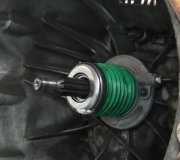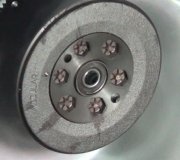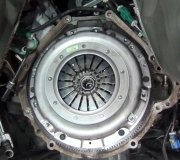Hi,
It sounds like the clutch master cylinder is bad. If the slave is new, there are no leaks, then the master cylinder is next. The idea that only a small amount of fluid comes out leads me to believe that is the issue.
Here are the directions for replacement. The attached pics correlate with the directions.
_____________________________
2004 Nissan-Datsun 350Z V6-3.5L (VQ35)
Removal and Installation
Vehicle Transmission and Drivetrain Clutch Clutch Hydraulic System Clutch Master Cylinder Service and Repair Procedures Removal and Installation
REMOVAL AND INSTALLATION
CLUTCH MASTER CYLINDER
pic 1
Removal and Installation
REMOVAL
1. Remove driver side kicking plate.
2. Remove footrest.
3. Remove dash side finisher (LH).
4. Remove instrument driver panel lower.
5. Remove VDC/TCS/ABS control unit.
6. Remove snap pin and clevis pin from the clevis, and separate it from clutch pedal.
Pic 2
7. Remove clips (5), and remove hood ledge cover (left).
8. Drain clutch fluid in the reservoir tank and remove hose from nipple.
CAUTION: Do not spill clutch fluid onto painted surfaces. If it spills, wipe up immediately and wash the affected area with water.
Pic 3
9. Remove the reservoir tank mounting nut and then remove the reservoir tank.
10. Using a flare nut wrench, remove clutch tube.
11. First remove nuts on master cylinder assembly, and then master cylinder assembly from the vehicle.
INSTALLATION
1. Connect clutch tube to master cylinder assembly and temporarily tighten flare nut.
2. Install master cylinder assembly and tighten mounting nut to the specified torque.
7.8 - 10 Nm (0.80 - 1.0 kg-m, 69 - 88 inch lbs.)
3. Using a flare nut torque wrench, tighten clutch tube flare nut to the specified torque.
15 - 17 Nm (1.6 - 1.7 kg-m, 11 - 12 ft. Lbs.)
4. Attach clevis of the clevis pin to the clutch pedal.
5. Attach snap pin to the clevis pin.
Pic 4
6. After mounting the hose over the nipple, install the reservoir tank in the vehicle.
7. After completing this procedure, inspect and adjust pedal height and then bleed the clutch tube.
Refer to "On-Vehicle Inspection and Adjustment" and "Bleeding".
8. Install hood ledge cover (left).
9. Install VDC/TCS/ABS control unit.
10. Install instrument driver panel lower.
11. Install dash side finisher (LH).
12. Install foot rest.
13. Install driver side kicking plate.
_________________________________
Here are the directions for bleeding.
________________________________
2004 Nissan-Datsun 350Z V6-3.5L (VQ35)
Procedures
Vehicle Maintenance Fluids Clutch Fluid Service and Repair Procedures
PROCEDURES
CLUTCH FLUID
Bleeding
CAUTION:
Monitor fluid level in the reservoir tank to make sure it does not empty.
Do not spill clutch fluid onto painted surfaces. If it spills, wipe up immediately and wash the affected area with water.
Bleed the operating cylinder.
Pic 5
1. Fill the master cylinder reservoir tank with new clutch fluid.
2. Connect a transparent vinyl hose to the air bleeder.
3. Depress the clutch pedal quickly and fully a few times and hold
4. With clutch pedal depressed, open air bleeder.
5. Close air bleeder.
6. Release clutch pedal and wait for 5 seconds.
7. Repeat steps 3 to 6 until no bubbles can be observed in the brake fluid.
Air bleeder: 5.9 - 9.8 Nm (0.61 - 0.99 kg-m, 53 - 86 inch lbs.)
__________________________________________________
Let me know if that takes care of the issue.
Take care and God Bless,
Joe
Images (Click to make bigger)
Thursday, February 18th, 2021 AT 7:46 PM







